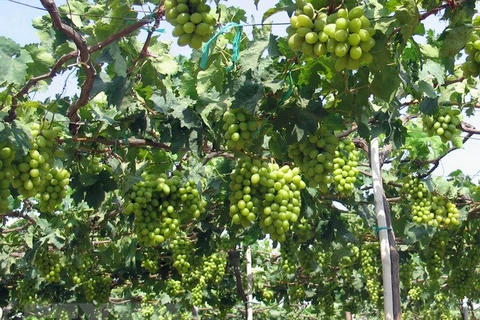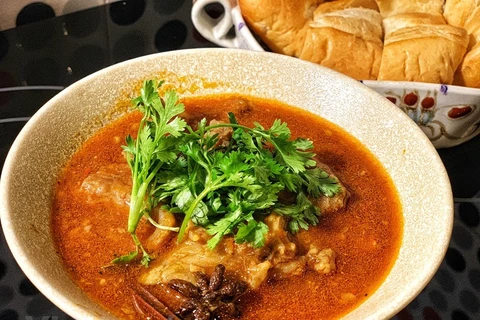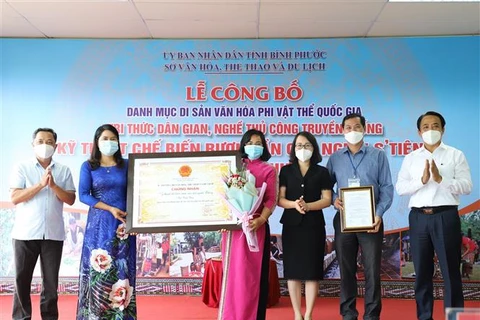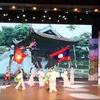 Can wine made by S'Tieng people in Bom Bo hamlet, Binh Minh commune, Bu Dang district of Binh Phuoc (Photo: VNA)
Can wine made by S'Tieng people in Bom Bo hamlet, Binh Minh commune, Bu Dang district of Binh Phuoc (Photo: VNA) Hanoi (VNA) - Making Can wine, a type of wine stored in a big jar and drunk with long bamboo straws, is a unique traditional craft that has been passed on from generation to generation of the S’Tieng ethnic minority group in the southern province of Binh Phuoc.
Folk knowledge and traditional craft are reflected in the appropriate identification and use of natural materials like leaves and bark, as well as a unique blend of leaf yeast with raw materials, such as paddy and rice to create a wine product with distinct flavours.
The technique has been recognised as a national intangible cultural heritage in terms of folk knowledge and traditional craft.
Can wine is also called "d’rap s’lung" or "ro nom d’rap" in the S'Tieng language.
However, it is commonly called "ruou can" in Vietnamese because it is usually drunk collectively through bamboo stems from a big jar. It is also called "stem wine" or "jar wine" by foreigners.
"Stem wine" is indigenous to several ethnic groups in Vietnam, particularly in the Central Highlands and the mountainous regions in the North.
It is made from sticky rice mixed with various kinds of herbs and yeast, including leaves, barks and roots gathered from the local forests.
This mixture is then put into a big terracotta jar, covered and left to ferment for one or two months. The type and amount of rice and yeast added differ according to each ethnic group and region.
The craft relies on the accurate identification and use of natural materials, as well as a unique blend of yeast and rice to create a wine with distinct flavours. The wine contributes to the richness and diversity of the culinary culture of Binh Phuoc, and Vietnam as a whole.
Unique drink
A legend about the history of the wine tells of two sisters who were orphaned at a young age and living together in a dilapidated hut. When the older sister married a landlord, she became cruel and mistreated her sister.
The younger sister was miserable, until one day a forest god appeared and taught her how to make rice wine. Following the instructions of the god, she took rice and forest leaves to ferment in a vase, burying it in the ground.
After 10 days, the girl dug up the wine, added warm water and brought it to the forest to worship the god. She was blessed with much wealth by the god, led a prosperous life and often helped the nearby villagers. Later, the girl was honoured by the S'Tieng people as the creator of the stem wine craft.
Stem wine comes in two types, sweet often for women and bitter for men, and each is about 10 to 20 percent alcohol by volume, with a strong aroma and a distinctive taste.
When the village holds a festival or a family has a wedding, the wine is an indispensable drink. Wine jars are placed in the most solemn place chosen by the elders. The jars are unsealed, plugged with bamboo stems and filled with water in advance of these important ceremonies.
Efforts to preserve ethnic wine
Currently, stem wine is made in many areas in Binh Phuoc, particularly in Bu Gia Map and Bu Dang districts. The method has been passed down from generation to generation.
Dieu Don, 70, in Hamlet 3, Dak O commune, Bu Gia Map, is one of the people who still preserve the craft of traditional winemaking.
According to Don, winemaking can be done according to an oral recipe, as a traditional craft, which is reflected in the correct identification and use of natural materials such as leaves and bark. Winemakers need to know how to blend yeast leaves with rice, creating a drink with a truly unique taste.
Inheriting the legacy of the previous generation, young people are also teaming up to preserve this special drink.
Dieu Thi Xia, 34, in Bom Bo hamlet, Binh Minh commune, Bu Dang district, has established a winemaking cooperative.
“Many sisters in the hamlet and I have taught people how to make the wine. The idea of expanding the business is to create opportunities for S'Tieng women in Bom Bo to have a stable income, and bring the traditional culture of winemaking to everyone,” Xia said.
Pham Huu Hien, deputy director of Binh Phuoc Provincial Museum, said that stem wine highlighted the cultural and spiritual values of the S'Tieng community in Binh Phuoc.
He emphasised that better preserving the heritage requires the joint efforts of many agencies and departments. At the same time, it is necessary to have appropriate conservation policies and let people know that such a heritage is not only a cultural product but also a consumer one.
According to Do Minh Trung, deputy director of the Department of Culture, Sports and Tourism of Binh Phuoc, to promote cultural heritage and contribute to the local socio-economic development, the elderly village artisans need to teach younger people how to preserve the technique of making the ethnic drink.
Binh Phuoc is famous for its old-age primitive culture. Many archaeological relics have been discovered that are around 2000 years old, such as Dan Da, stone tools, and pottery belonging to the civilisation of primitive societies.
The province also has many historic sites connected to the national liberation movement; Phu Rieng was the movement of workers in Phu Rieng rubber plantation during the war against France; Ba Ra prison where the French colonists kept patriotic Vietnamese soldiers; the Base of High Command of army forces in the South of Vietnam; Soc Bom Bo where the S'Tieng grew rice day and night to feed soldiers, and many other places which protected our soldiers in the two wars against foreign invaders.
In addition, Binh Phuoc is also where many natural landscapes are hidden in large forests such as Thac Mo, Soc Xiem lake, Ba Ra mountain, Suoi Lam historic site, Bu Gia Map primaeval forest and Cat Tien national park./.
























